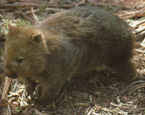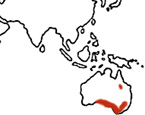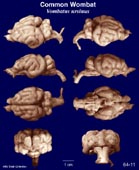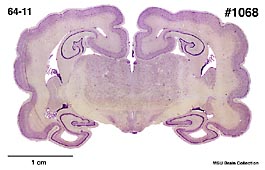|
Common
Wombat
(Vombatus ursinus) #64-11 |
||||
|
|
Physical
characteristics and distribution
|
|
Head
and body length is 700-1200 mm, the tail being a stub. Adults
weigh between 15-35 kg. Color ranges from a buffy yellow, silver
gray, light gray, dark brown or black. The fur is coarse and
harsh. The nose is hairless and the ears are small and rounded.
V. ursinus, as well as the genus Lasiorhinus,
are the only two living marsupials to possess two rootless incisors
in each jaw, a feature also found in rodents. There is an odd
gland patch present in the lesser curvature of the stomach.
This patch is also found in the Koala and the Beaver. On the
female, the patch has a posterior opening and contains two mammae.
The
diet consists of grasses, roots and fungi, preferring fresh
seed stems. It uses its forefeet to grasp and tear the vegetation.
|
|
Description
of the brain
|
|
Animal
source and preparation
|
|
All
specimens collected followed the same preparation
and histological procedure.
|
Other Related Resources (websites and publications)
List of Specimens | Explore Collections | Brain Sections | Brain Evolution | Brain Development | Brain Circuitry | Brain Functions | Location and Use | Related Web Sites | Contact Us | Search MSU Database | Personnel | Home



